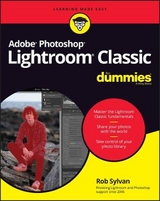
Adobe Photoshop Lightroom Classic For Dummies
John Wiley & Sons Inc (Verlag)
978-1-119-54496-8 (ISBN)
- Titel erscheint in neuer Auflage
- Artikel merken
Whether you are brand new to photography, a devoted enthusiast, or a seasoned pro, there’s a version of Lightroom for you.
Lightroom For Dummies is the book to help you learn which version of Lightroom is right for your needs. The main focus of the book is on using Lightroom Classic, but also includes an introduction to Lightroom CC. All with the goal of helping you get started on the right foot toward taking your photographic workflow to the next level. The book is a great starting place to help you improve your family photos or add advanced Lightroom skills that aid your career. Look inside to find the steps to navigating the software and getting top-notch results.
Deciding which version of Lightroom is the best fit
Take control of your photo library with Lightroom Classic
Importing, organizing, and finding photos
Editing and sharing your photos
Producing a slideshow, book, print, or web gallery
Gain a foundation for getting started with Lightroom CC
Get ready to spend less time in front of the computer and more time behind the lens!
Rob Sylvan has been answering Lightroom questions on the KelbyOne Help Desk since Lightroom 1.0 was released in 2007. A photographer, writer, and educator, Rob teaches Lightroom and Photoshop classes at trade shows, conferences, and camera clubs around the US. He's also an adjunct faculty member at New Hampshire Technical Institute.
Introduction 1
About This Book 1
How This Book is Organized 2
Part 1: Getting Started with Lightroom Classic 2
Part 2: Managing Your Photos with Lightroom Classic 3
Part 3: Working in Lightroom Classic’s Digital Darkroom 3
Part 4: Sharing Your Work with the World 3
Part 5: The Part of Tens 3
Conventions Used in This Book 3
Icons Used in This Book 4
Beyond the Book 5
Where to Go from Here 5
Part 1: Getting Started with Lightroom Classic 7
Chapter 1: Getting to Know Adobe Photoshop Lightroom Classic 9
The Two Versions of Lightroom 10
Understanding the Creative Cloud 11
Creative Cloud Photography Plan 11
Figuring out whether Lightroom Classic is right for you 12
Knowing whether you need the new Lightroom 13
Introducing the Lightroom Classic Interface 14
Getting what makes each module unique 14
What the Lightroom Classic modules have in common 18
Controlling the Lightroom Classic interface 21
Using Lightroom Classic’s secondary display view 23
Getting Up and Running 25
Preparing for installation 25
Chapter 2: Working with Catalogs 27
Understanding How the Catalog Works 27
One catalog to rule them all 28
Knowing where the catalog is located 29
Choosing which catalog to open 31
Caring for the Catalog 32
Backing up your catalog 33
Optimizing your catalog 36
Managing the preview cache files 36
Exploring the Metadata options 40
Working with Multiple Catalogs 42
Transferring data between catalogs 42
Exporting a catalog 43
Importing from a catalog 44
Chapter 3: Lightroom Classic Basics That You Should Know 47
Configuring Lightroom Classic Preferences 47
General preferences 48
The Presets preferences 49
The External Editing preferences 50
Setting up additional external editors 52
The File Handling preferences 53
The Interface preferences 54
The Performance preferences 56
The Lightroom Sync preferences 58
The Network preferences 58
Local Storage versus Cloud Storage 59
Local storage 59
Cloud storage 59
What if I stop my subscription? 60
Getting Familiar with File Formats 61
Supported file formats 62
Making sense of bit depth 63
Understanding color spaces 64
Part 2: Managing Your Photos with Lightroom Classic 67
Chapter 4: Tackling the Lightroom Classic Import Process 69
Knowing How the Import Process Works 69
Exploring the Import Dialog 70
Importing Your Photos into Lightroom Classic 74
Employing an effective import workflow 74
Putting it all together 82
Auto Import 84
Shooting Tethered 87
Chapter 5: Viewing and Finding Photos in the Library 91
Exploring the Library Module 91
Getting to know the panels and tools 92
Becoming familiar with the menu options 94
Creating a custom identity plate 95
Choosing the Right View for the Task 98
Working with thumbnails in Grid view 99
Taking a closer look in Loupe view 102
Using the Panels to Access Your Photos 105
Getting the 20,000-foot view from the Catalog panel 105
Using the Folders panel like a file browser 106
Grouping photos into collections 110
Creating Multiple Versions with Virtual Copies 114
Chapter 6: Getting Organized with the Library 117
Evaluating Photos 118
Survey view 118
Compare view 120
Flags, Ratings, and Color Labels 121
Using flags to pick the winners and losers 122
Deleting photos from Lightroom Classic 124
Using ratings to rank images 125
Applying color labels 126
Filenames and Metadata 127
Batch renaming with filename templates 127
Creating metadata templates to embed information into each image 128
Keywording 130
Adding and organizing keywords 131
Using the Keyword List to find photos 135
Using the Painter Tool 136
Finding Photos with the Library Filter Bar 136
Chapter 7: Exploring the Library Module’s Advanced Features 139
People View 139
Finding faces 140
Tagging faces with names 141
Adjusting Your Photos in the Library 144
Considering the Histogram 144
Making adjustments with Quick Develop 145
Merging Photos into HDR and Panos 147
Photo Merge to HDR 147
Photo Merge to Panorama 149
Photo Merge to HDR Pano 151
What is DNG? 153
Types of DNG 153
Converting to DNG 154
Putting Photos on the Map 156
Getting oriented to the Map module 156
Map module basics 157
Part 3: Working in Lightroom Classic’s Digital Darkroom 159
Chapter 8: Editing Photos in the Develop Module 161
Exploring the Develop Module 162
Getting to know the panels and tools 162
Becoming familiar with the menu options 164
Understanding the view options 164
Applying settings to other photos 167
Development Essentials 169
Using the Histogram panel 170
Making basic adjustments 172
Choosing a starting profile 173
Controlling color casts 176
Adjusting tonal range to bring out the best 178
Making images pop 180
Customizing panel order 180
Chapter 9: Solving Problems and Saving Time 183
Fixing Common Problems 183
Stronger compositions through cropping 184
Removing spots and healing blemishes 186
Correcting red-eye problems 189
Correcting pet eye problems 191
Graduated Filter 192
Radial Filter 198
Adjustment Brush 199
Presets, Snapshots, and History 201
Saving time with presets 201
Freezing time with snapshots 203
Going back in time with the History panel 204
Chapter 10: Taking Your Photos to the Next Level 205
Working with Contrast and Color 206
Mastering the Tone Curve 206
Enhancing and changing colors 210
Creating black-and-white images 211
Adding color to shadows and highlights 214
The Devil’s in the Details 215
Applying capture sharpening 216
Dealing with noise 220
Correcting lens distortions and vignetting 222
Reducing chromatic aberration 223
Transforming perspective distortions 225
Creative Effects 227
Creative vignette applications 228
Creative grain applications 230
Modifying the Calibration Settings 230
Part 4: Sharing Your Work with the World 233
Chapter 11: Exporting Copies and Using External Editors 235
Exploring the Export Dialog 236
Creating Copies of Processed Photos 238
Employing an export workflow 238
Saving settings as a preset for reuse 252
Configuring Your External Editors 253
Basic Editing in an External Editor 257
Advanced Editing Options with Photoshop 259
Chapter 12: Designing a Book 263
Exploring the Book Module 263
Getting to know the panels and tools 264
Becoming familiar with the menu options 265
Setting Up a Book 266
Employing a book workflow 266
Some things to keep in mind 279
Chapter 13: Producing a Slideshow 281
Exploring the Slideshow Module 281
Getting to know the panels and tools 282
Becoming familiar with the menu options 283
Creating a Slideshow 284
Employing a slideshow workflow 284
Playing the Slideshow for Your Audience 297
Playback 297
Export 298
Chapter 14: Printing Your Work 301
Exploring the Print Module 301
Getting to know the panels and tools 302
Becoming familiar with the menu options 304
Setting Up a Print Job 305
Employing a print workflow 305
Chapter 15: Creating a Web Gallery 323
Exploring the Web Module 323
Getting to know the panels and tools 324
Becoming familiar with the menu options 325
Creating a Web Gallery 326
Employing a web gallery workflow 326
Web Gallery Output Options 334
Uploading your gallery with Lightroom Classic 334
Exporting your gallery 337
Part 5: The Part of Tens 339
Chapter 16: Ten Things to Know About Using Lightroom Classic and Lightroom Together 341
Why Would You Use Them Together? 342
Know Before You Go 343
Setting It Up 343
Lightroom Classic Preferences 344
Syncing Collections from Lightroom Classic 345
Making Collections Public 346
All Synced Photographs 346
Collections or Albums? 347
Lightroom for Mobile Interface 347
Change is a Constant 348
Chapter 17: Ten Things to Know About Organizing and Editing in Lightroom 349
Help & Support 350
All Photos and Filtering 350
Segmentation and View Options 351
Adobe Sensei Search 351
Adding Photos from Camera Roll 352
Apply During Import 354
Creating Albums and Folders 354
Applying Ratings and Flags 356
Edit Photos Anywhere 356
Export Copies 358
Chapter 18: Ten Things to Know About Using the Lightroom Mobile Camera 361
Shooting in Raw Mode (DNG) 362
Shooting in Professional Mode 362
Using Shoot-through Presets 364
Helpful Overlays 365
Self Timer, Burst Mode, and Remote Trigger 366
Last Photo Preview 366
Exposure Lock 366
In-Camera HDR Mode 367
Take a Selfie or Switch Lenses 367
Camera Launch Shortcuts 367
Index 369
| Erscheinungsdatum | 10.07.2019 |
|---|---|
| Verlagsort | New York |
| Sprache | englisch |
| Maße | 189 x 242 mm |
| Gewicht | 802 g |
| Themenwelt | Informatik ► Grafik / Design ► Photoshop |
| Informatik ► Web / Internet ► Web Design / Usability | |
| ISBN-10 | 1-119-54496-3 / 1119544963 |
| ISBN-13 | 978-1-119-54496-8 / 9781119544968 |
| Zustand | Neuware |
| Informationen gemäß Produktsicherheitsverordnung (GPSR) | |
| Haben Sie eine Frage zum Produkt? |
aus dem Bereich



